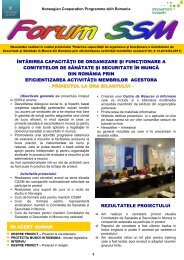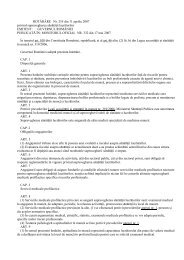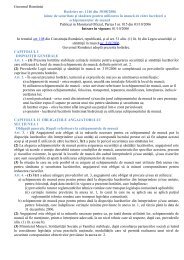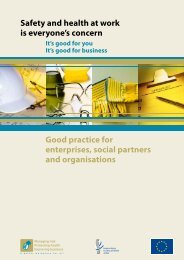Preventing work-related musculoskeletal disorders - European ...
Preventing work-related musculoskeletal disorders - European ...
Preventing work-related musculoskeletal disorders - European ...
You also want an ePaper? Increase the reach of your titles
YUMPU automatically turns print PDFs into web optimized ePapers that Google loves.
<strong>Preventing</strong> <strong>work</strong>-<strong>related</strong> <strong>musculoskeletal</strong> <strong>disorders</strong><br />
was coined to describe a situation in which the employee is entirely<br />
constrained by the rhythm of production line <strong>work</strong>ing and is not<br />
free, for example, to decide when to take breaks or to arrange a<br />
brief respite from his <strong>work</strong>. These tightly constrained forms of <strong>work</strong><br />
organisation have become very widespread in modern economies, in<br />
both the industrial and service sectors. The concepts of ‘lean<br />
production’ and other similar forms of production management<br />
have often been reflected by greater time constraints directly<br />
affecting the <strong>work</strong> station and greater density of movements<br />
required by eliminating <strong>work</strong> in progress and opportunities for local<br />
adjustment of activity. Thus, specific forms of <strong>work</strong> organisation<br />
become essential keys to the understanding of the occurrence of<br />
MSDs and constitute a source of possible solutions to be explored.<br />
(See Fabrice Bourgeois’ article later in this magazine).<br />
As regards links with psychosocial factors relating to the <strong>work</strong>ing<br />
environment, the studies referred to above demonstrate the<br />
importance of analysing the following criteria and the way in which<br />
employees perceive them: the monotony of the tasks to be<br />
performed; the possibility of identifying one’s own contribution to<br />
the end product; the quality of relations within the <strong>work</strong>ing groups<br />
and relations with the hierarchy; freedom of independent action and<br />
responsibility; the opportunity to produce high-quality <strong>work</strong>;<br />
problems with reconciling the simultaneous requirements of speed<br />
and quality; anxiety about the future, etc.. There are also stronger<br />
and stronger assumptions of endocrine links between stress and<br />
MSDs. At the very least, <strong>work</strong> situations that are perceived<br />
negatively from the standpoint of psychosocial factors would be<br />
capable of triggering both physical and mental <strong>disorders</strong>. (See Jason<br />
Devereux’s article)<br />
These various elements highlight the subjective aspect of the<br />
individual’s commitment to <strong>work</strong> and open up new avenues for<br />
investigation. Thus, hyperstress could be an avenue for the release<br />
of psychological pain, the somatisation of the unhappiness<br />
experienced in doing <strong>work</strong> that has lost its meaning. In this case,<br />
MSDs would reveal a<br />
conflict between the<br />
individual and the <strong>work</strong> The explanation for many<br />
organisation which no<br />
longer recognises the MSD situations could lie in<br />
creative and social<br />
a new balance between<br />
capabilities of the <strong>work</strong>ers.<br />
The explanation for many biomechanical and<br />
MSD situations could thus<br />
lie in a new balance<br />
psychosocial factors.<br />
between biomechanical<br />
and psychosocial factors.<br />
BROADENING THE FIELD OF PREVENTION<br />
Despite these problems with understanding MSDs, their prevention is<br />
possible. On condition, however, that this global aspect of movement<br />
is taken into account and the appropriate conclusions drawn by<br />
broadening the range of areas in which changes are made: measures<br />
affecting the <strong>work</strong> station, certainly, but also measures affecting <strong>work</strong><br />
organisation and the <strong>work</strong>ing environment. Hence there is a need for<br />
technical solutions involving <strong>work</strong>station reorganisation to reestablish<br />
biomechanically acceptable limits (reduction of physical effort, correct<br />
scaling of <strong>work</strong>stations, reorganisation of <strong>work</strong>ing spaces, etc.) but<br />
also measures targeted at <strong>work</strong> organisation and taking account of<br />
the psychosocial factors (job rotation with learning and allowing<br />
<br />
DEFINING THE PROBLEM<br />
The World Health Organisation has defined a<br />
<strong>work</strong> <strong>related</strong>-disorder as one that results from<br />
a number of factors, and where the <strong>work</strong><br />
environment and the performance of the <strong>work</strong><br />
contribute significantly, but in varying<br />
magnitude, to the causation of the disease.<br />
Some of the <strong>disorders</strong> classified as <strong>work</strong><strong>related</strong><br />
<strong>musculoskeletal</strong> <strong>disorders</strong> (WMSDs)<br />
exhibit well defined signs and symptoms, for<br />
example, rotator cuff tendinitis, carpal tunnel<br />
syndrome and acute prolapsed inter-vertebral<br />
disc. Many others are less well defined such as<br />
myalgic conditions involving pain, discomfort,<br />
numbness and tingling sensations throughout<br />
the neck shoulders, upper limbs and lower<br />
back. These types of disorder, that are<br />
sometimes called non-specific WMSDs, often<br />
cannot be diagnosed with respect to a clinical<br />
pathology but they may still result in physical<br />
impairment and disability.<br />
WMSDs therefore, cover a wide range of<br />
inflammatory and degenerative diseases of the<br />
locomotor system. They include:<br />
• inflammations of tendons (tendinitis and<br />
tenosynovitis), especially in the forearmwrist,<br />
elbow and shoulder, evident in<br />
occupations involving prolonged periods of<br />
repetitive and static <strong>work</strong>;<br />
• myalgias, i.e. pain and functional<br />
impairments of muscles, occurring<br />
predominantly in the shoulder-neck region,<br />
that occur in occupations with large static<strong>work</strong><br />
demands;<br />
• compression of nerves – entrapment<br />
syndromes – occurring especially in the<br />
wrist and forearm;<br />
• degenerative <strong>disorders</strong> occurring in the<br />
spine, usually in the neck or lower back,<br />
especially in those performing manual<br />
handling or heavy physical <strong>work</strong>. However,<br />
they may also occur in the hip or knee<br />
joints.<br />
These <strong>disorders</strong> are chronic, and symptoms<br />
usually occur only after exposure to <strong>work</strong><strong>related</strong><br />
risk factors for a period of time.<br />
There is little evidence of the use of<br />
standardised diagnostic criteria for WMSDs<br />
across Member States of the <strong>European</strong> Union,<br />
and a range of terms have been used in<br />
different countries to describe these <strong>disorders</strong>.<br />
For example, when they affect the upper<br />
limbs, the terms include Repetitive Strain<br />
Injuries (RSI), Work-Related Upper Limb<br />
Disorders (WRULDs), Trouble Musculo-<br />
Squelettiques (TMS) and Cumulative Trauma<br />
Disorders (CTD). This variation is reflected in<br />
the nationally reported data as well as the<br />
research literature and makes comparisons<br />
between Member States difficult.<br />
Attempts have been made to reach acceptable<br />
levels of agreement between healthcare<br />
professionals on definitions for some WMSDs<br />
(Harrington et al., 1998, Sluiter et al.,2000)<br />
and these should be considered as a basis for<br />
establishing a consensus that may be used<br />
more widely for primary prevention and in<br />
<strong>work</strong>place surveillance.<br />
Peter Buckle and Geoff David<br />
REFERENCES:<br />
1 Harrington, JM, Carter JT, Birrell, L and Gompertz D<br />
(1998) `Surveillance case definitions for <strong>work</strong>-<strong>related</strong><br />
upper limb pain syndromes’ Occupational and<br />
Environmental Medicine, v55, 4, p264 271<br />
2 Sluiter, J.K., Visser, B. & Frings-Dresen, M.H.W. (2000)<br />
Concept guidelines for diagnosing <strong>work</strong>-<strong>related</strong><br />
<strong>musculoskeletal</strong> <strong>disorders</strong>: the upper extremity. Coronel<br />
Institute of Occupational and Environmental Health,<br />
Amsterdam Medical Center, University of Amsterdam,<br />
The Netherlands.<br />
<strong>European</strong> Agency for Safety and Health at Work<br />
5








